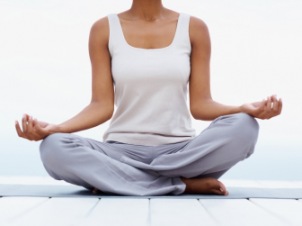Simple guide to meditation
By Jessica, October 11, 2010

Meditation is a valuable tool for facing the stresses and strains of modern life. A big part of what makes us stressed is external factors that we have no control over. Meditation won’t get rid of these things, but it can help to give you the calm and peace of mind to face them head-on.
Set aside time to meditate
Make time in your daily routine to meditate. You will benefit from meditation more if it is something that you do regularly and not just once in a while. For some, 5 minutes spent meditating will be enough. Some like to start their day by meditating, but others like to end their day with it. When learning to meditate, the morning is the easiest time of the day to meditate as you haven’t yet experienced stress from the day ahead and will have fewer negative thoughts to block out.
Find somewhere quiet
It’s important when learning to meditate to get rid of any potential distractions. Turn off the TV, mobile, and other noisy appliances. You may choose to play music when you meditate, if you do play gentle and repetitive music that won’t break your focus. If you meditate outside you are privy to environmental noise from roads or other people. You could listen to music in headphones once it is not too loud.
Sit on the ground/floor
Sitting cross legged at ground level is the most popular meditation position for beginners. The most important thing is that you keep your back straight to help your breathing. Tilt your pelvis forward. If you are sitting on a cushion it helps to sit right on the edge as sitting too far back will make you slouch and make your pelvis tip back.
Straighten your back starting from the bottom of your spine right through to the top. If you are sitting correctly holding this position won’t feel uncomfortable. Relax your arms. It doesn’t matter if they are on your lap or hanging by your side once they are loose and not tensed up.
Be aware of your body
Try to become aware of parts of your body that are not relaxed and relax them. If you find this difficult try adjusting your posture slightly. Make sure your back is straight and not twisted.
Pay attention to your breath
Listen to your breath but don’t become overly aware of it. For example if you are sitting thinking that your breathing sounds raspy you are not completely focused on the meditation. To breathe deeply, breathe in through your nose until your stomach rises, then breathe out through your mouth.
The goal is to silence the inner voice that tells you to be aware of such things normally. Many people use an “anchor” to settle their mind for example the Om chant used in meditations in Hinduism Buddhism or Jainism. You can also count your breaths in sets of 10, i.e counting them to 10 then starting at 1 again. Visualise a place that calms you. Imagine yourself walking to it, and when you arrive you are fully relaxed.
Silence your inner voice
After you learn to clear your mind of unnecessary thought, you need to learn how to silence your inner voice. Keep the image of your peaceful place in your mind. As other thoughts enter your head you can choose to cast them aside or observe impartially without letting yourself decide if they are positive or negative thoughts. The relaxing place you visualise will help to ground you in your meditation, if other thoughts seep in send yourself back to this place.
Initially when you learn to meditate silence is key, but as you practice you will soon learn to meditate anywhere. Just like people who can become so immersed in a book they are able to shut out noise, you can learn to be that silent in your own thoughts. But first, you have to learn to tame your mind.




